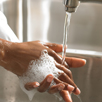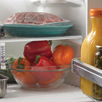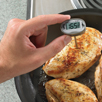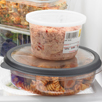
Food and Waterborne Illness Complaint Line : 770.339.4BUG
Food Safety at Home
Do you know how to reduce the risk of foodborne illness in your home? There are four simple steps you can use in your kitchen to help keep your family safe:
1) Clean: Wash hands and surfaces often
 Why it matters
Why it matters
Illness-causing bacteria can survive in many places around your kitchen, including your hands, utensils, and cutting boards. Unless you wash your hands, utensils, and surfaces the right way, you could spread bacteria to your food, and your family.
Wash hands the right way—for 20 seconds with soap and running water. Washing your hands the right way can stop the spread of illness-causing bacteria.
Wash surfaces and utensils after each use. Bacteria can be spread throughout the kitchen and get onto cutting boards, utensils, and counter tops. Create your own sanitizing solution by mixing 1/2 teaspoon of bleach with 1 gallon of water.
Wash fruits and veggies—but not meat, poultry, or eggs! Did you know that—even if you plan to peel fruits and veggies—it’s important to wash them first because bacteria can spread from the outside to the inside as you cut or peel them?
2) Separate: Don’t cross-contaminate

Why it matters
Even after you’ve cleaned your hands and surfaces thoroughly, raw meat, poultry, seafood, and eggs can still spread illness-causing bacteria to ready-to-eat foods—unless you keep them separate.
But which foods need to be kept separate, and how?
Use separate cutting boards and plates for produce and for meat, poultry, seafood, and eggs. Placing ready-to-eat food on a surface that held raw meat, poultry, seafood, or eggs can spread bacteria and make you sick. But stopping cross-contamination is simple.
Keep meat, poultry, seafood, and eggs separate from all other foods at the grocery. Make sure you aren’t contaminating foods in your grocery bag. Separate raw meat, poultry, seafood, and eggs from other foods in your shopping cart. At the checkout, place raw meat, poultry, and seafood in plastic bags to keep their juices from dripping on other foods.
Keep meat, poultry, seafood, and eggs separate from all other foods in the fridge. Bacteria can spread inside your fridge if the juices of raw meat, poultry, seafood, and eggs drip onto ready-to-eat foods.
3) Cook: Cook to the right temperature

Why it matters
Did you know that the bacteria that cause food poisoning multiply quickest in the “Danger Zone” between 40˚ and 140˚ Fahrenheit?
And while many people think they can tell when food is “done” simply by checking its color and texture, there’s no way to be sure it’s safe without following a few important but simple steps
Use a food thermometer. Cooked food is safe only after it’s been heated to a high enough temperature to kill harmful bacteria. Color and texture alone won’t tell you whether your food is done. Instead, use a food thermometer to be sure.
Keep food hot after cooking (at 140 ˚F or above). The possibility of bacterial growth actually increases as food cools after cooking because the drop in temperature allows bacteria to thrive. But you can keep your food above the safe temperature of 140˚F by using a heat source like a chafing dish, warming tray, or slow cooker.
Microwave food thoroughly (to 165 ˚F). To make sure harmful bacteria have been killed in your foods, it’s important to microwave them to 165˚ or higher.
4) Chill: Refrigerate promptly

Why it matters
Did you know that illness-causing bacteria can grow in perishable foods within two hours unless you refrigerate them? (And if the temperature is 90 ˚F or higher during the summer, cut that time down to one hour!)
But by refrigerating foods promptly and properly, you can help keep your family safe from food poisoning at home.
Refrigerate perishable foods within two hours. Cold temperatures slow the growth of illness causing bacteria. So it’s important to chill food promptly and properly.
Never thaw or marinate foods on the counter. Many people are surprised at this tip. But since bacteria can multiply rapidly at room temperature, thawing or marinating foods on the counter is one of the riskiest things you can do when preparing food for your family. To thaw food safely, choose one of these options:
-
-
- Thaw in the refrigerator. This is the safest way to thaw meat, poultry, and seafood. Simply take the food out of the freezer and place it on a plate or pan that can catch any juices that may leak. Normally, it should be ready to use the next day.
-
- Thaw in cold water. For faster thawing, you can put the frozen package in a watertight plastic bag and submerge it in cold water. Be sure to change the water every 30 minutes. Note: If you thaw this way, be sure to cook the food immediately.
-
- Thaw in the microwave. Faster thawing can also be accomplished in the microwave. Simply follow instructions in your owner’s manual for thawing. As with thawing in cold water, food thawed in the microwave should be cooked immediately.
-
Cook without thawing. If you don’t have enough time to thaw food, just remember, it is safe to cook foods from a frozen state—but your cooking time will be approximately 50% longer than fully thawed meat or poultry.
To marinate food safely, always marinate it in the refrigerator.
Know when to throw food out. You can’t tell just by looking or smelling whether harmful bacteria has started growing in your leftovers or refrigerated foods.
Be sure you throw food out before harmful bacteria grows by checking this Safe Storage Times chart.
For more information visit:
Food and Waterborne Illness Complaint Line : 770.339.4BUG


